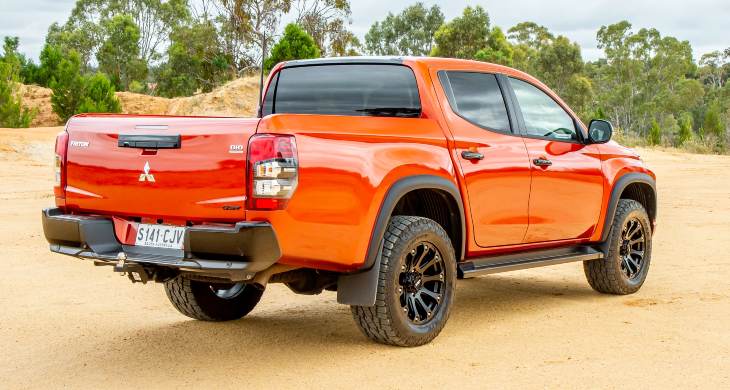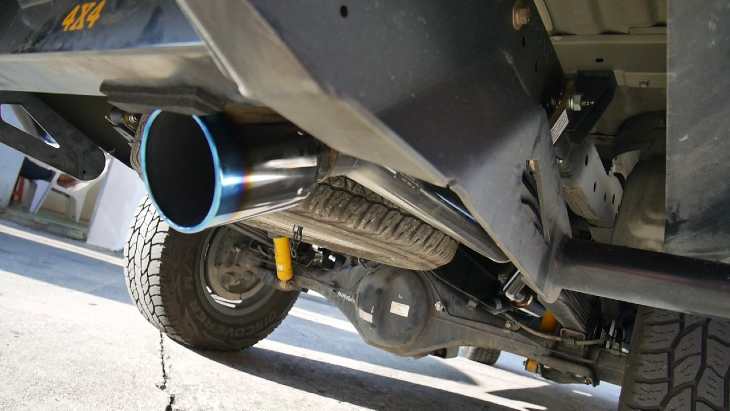Utes are definitely making a dent in Aussies’ wallets, but they’re an investment well worth having. They’re tough, reliable and can go anywhere, well almost. The best selling ute as of March 2022 is the Mitsubishi Triton, with over 3800 units in that month alone. This undercuts all rivals by a large margin. The popularity of the Triton is down to price, decent specs and build, and reliability from a trusted company. It was just edged out by the Toyota RAV4 in overall vehicle sales, but unhinged by the fact that there’s a replacement just around the corner.
The 2.4-litre turbo-diesel delivers bucket loads of torque, good for when you’re negotiating steep inclines on loose surfaces, or towing a few tonnes worth of camping gear. All of the 133 kW is available early on in the rev range, so you won’t be working the pedal and engine as much. Diesels are tuned for outright pulling power and efficiency, though with revs limited there’s a slight lack of power higher up. Speed is better accessed with mild upgrades, that extend the power band. Here, a Mitsubishi Triton exhaust is the first upgrade you’ll want if you’re shopping for more performance. And it sets the foundations for any mods you do down the road.

source: pinterest.com
Why Consider an Aftermarket Performance Exhaust?
With all the metal going into big utes, to keep prices down carmakers need to cut a few corners. This is in areas that aren’t at first evident. Stock exhausts are barely passable in this respect. They consist of mill-of-the-run tubing engineered through unnecessary twists and bends to fit in the underbody and sourced in mild steel. The design robs the engine of breathing space for optimal performance.
Narrower exhaust tubes aren’t the ideal solution for the best airflow, and this is what you want if power is your goal. The limited space can cause issues with backpressure, or gas fumes making their way back into the cylinders. It also prevents exhaust scavenging, or the vacuum created in the tubes as each cylinder does its thing. Scavenging helps in faster gas flow and allows for a new batch of fresh air ready for combustion. It also relieves exhaust valves and cams from extra work.
An aftermarket performance exhaust for the Triton, then, means optimal airflow along the whole length of the exhaust, so gases can exit faster. And this translates to more power, with the cycle of combustion coming on sooner. It also means that parts are less stressed, as there’s lower pressure and temperatures hitting the exhaust walls, something you’ll definitely see with an installed EGT gauge.
Benefits of Aftermarket Exhausts
So, there’s better overall performance and less wear to the engine internals. But what else does an aftermarket exhaust offer? Apart from better materials (and less weight), that will last longer when pushed through the usual off-road beating, there’s better sound. Tubing combos are straighter here, meaning you’ll hear more of the engine roar. And there are different sound profiles to choose from. Prices are matched to performance gains, but come in far cheaper than other upgrades.
Types of Exhausts for the Triton

source: 4x4venhicles.com
Depending on the engine in your ute, there are different Mitsubishi Triton exhaust systems sold. The differences go along the lines of fuel, with petrol and diesel exhaust systems with different parts, and whether the engine is turbocharged. Newer 2.4 litre and the previous-gen 2.5 and 2.8-litre diesels are turbocharged. You’ll also find the naturally-aspirated in-line 4 cylinder petrols in the older Tritons with lower trim levels.
Cat-back exhausts are more for better engine sound. The tubing is straighter and wider in all parts from the catalytic converter to the tailpipes and exhaust tips. This is in Tritons with a petrol engine. The sounds can be adjusted with the addition of resonators and different muffler profiles, and can go anywhere from a silent exhaust, to one that has more presence.
Performance gains are to be found in DPF-back diesel specific exhaust systems, that use wider and straighter tubes from the particle filter. Here there is more metal added to the mix, with tubes coming in at 3.5 inches for better and faster exhaust flow. All parts from the filter to the tips are swapped out, and like cat-back systems, there’s the choice to add resonators and mufflers when tuning the sound. This combination will give you a few more horses, that are welcome when driving in difficult terrain and with the engine working harder.
For turbocharged diesels, the most power comes from a turbo-back exhaust, which can also have modified exhaust manifolds. These systems swap out the whole stock exhaust. They can also include better scavenging with included downpipes and extractors. The benefits are also there for the turbine, with exhaust gases used for quicker and earlier spooling. This is where the majority of added power comes from, and is available through a wider rev range. Some estimates put gains in the vicinity of 10 per cent or more.
What to Look for in an Aftermarket Exhaust?
The short answer is – Australian-built exhausts which are made from high-grade steel alloys with exterior coatings and included mounting brackets for easy installation. Look for hand-built exhausts that have undergone mandrel bending to preserve uniform widths and prevent kinking. The use of 409 stainless steel means exceptional strength and resistance to wear and damage even in more difficult terrain or weather conditions. Coatings add corrosion and heat resistance. Flexible high-quality joints, flanges and brackets reduce vibration (and sound) coming into the cabin. They also mean better usability off-road.
Most aftermarket exhausts require minimal work during installation, as parts fit within the underbody recesses housing the factory exhaust. Look for Triton exhausts in 4×4 accessories stores or exhaust specialists.


















